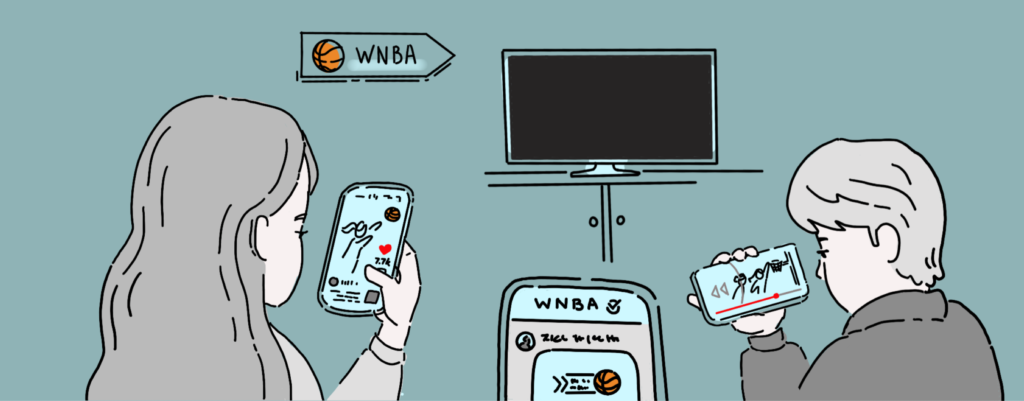
Graphic by Evelyn Kim ’25/The Choate News
By Ethan Zhang ’26
The Women’s National Basketball Association (WNBA) has long been criticized for relying on the National Basketball Association’s (NBA) revenue to stay afloat. Simply put, the WBNA does not generate enough revenue from viewers to even profit, let alone match gigantic NBA-level contracts. However, improved social media marketing can change that.
Social media has pushed the narrative that WNBA stars are untalented and unathletic through the spread of cherrypicked lowlights that amass hundreds of thousands of views from uninformed, social-media-reliant users. This has prevented many potential fans from watching the WNBA. As a result of its comparatively low revenue generated from ticket sales and sponsorships, a significant wage gap exists between WNBA and NBA contracts — the average WNBA salary being $103,000 and the NBA’s being $9.4 million.
Despite the widespread impact of these social media posts the WNBA reached its highest viewership total in 21 years during the 2023 regular season. Some may argue that the rising talent of female athletes has created this recent surge in women’s basketball viewership. While that may be true, there have always been talented female athletes; they just went unrecognized on social media and, consequently, amongst mass audiences.
A watershed moment in the public reception of women’s basketball has been the most recent NCAA season. The Women’s March Madness game on April 1 between Louisiana State University’s (LSU) Tigers and the University of Iowa’s Hawkeyes had a record-breaking 12.3 million viewers — the most in collegiate basketball history. Moreover, clips and edits of NCAA players — Iowa’s Caitlin Clark, Louisiana State University’s Angel Reese, and the University of Connecticut’s (UCONN) Paige Bueckers — posted by both fans and athletes themselves are getting millions of views and, for once, these videos highlight their athleticism instead of tastelessly ridiculing them.
Thanks to social media, the young female players of the NCAA have appealed to audiences that the WNBA failed to reach. Through viral clips of fierce rivalries, flashy passes, and physical brawls, social media is proving to basketball fans that women’s basketball is just as entertaining as men’s. The recent surge in viewership for women’s collegiate basketball has bled into audience reception of the WNBA.
As collegiate players get drafted into the WNBA, the league is bound to continue garnering popularity and, eventually, the average WNBA salary may rise. While social media has been extremely influential for both women’s collegiate and professional basketball, trends on social media always die down eventually. In other words, though college athletes have spotlighted the WNBA, the professional league will have to find new ways to keep viewers engaged if there are to be any salary changes.
For the WNBA to grow, increased partnerships with the NBA and better marketing are essential to obtaining long-term fans rather than temporary viewers. Fortunately, the WNBA and NBA are already taking steps to help create a larger, more sustainable fanbase for the WNBA. WNBA point guard Sabrina Ionescu went head-to-head with Stephen Curry in a three-point contest at the 2024 NBA All-Star Game and Ice Cube’s $5 million Big3 league contract offer to Caitlin Clark are both major steps towards a larger, more sustainable fanbase in the WNBA.
In the past, social media has been used to push the misogynistic narrative that women’s basketball is unsuccessful because their players are unathletic. However, increased viewership for women’s basketball and a recent shift in this narrative, all as a result of social media, show that online sharing platforms are not inherently bad. Even so, fully controlling social media is impossible. Trends come and go, and women’s basketball’s popularity could shift again. If WNBA marketing teams can jump onto the success of these college stars and keep the spotlight on all the skill and talent in this generation of female players, then a decrease in the wage gap between the WNBA and NBA is bound to take place.




